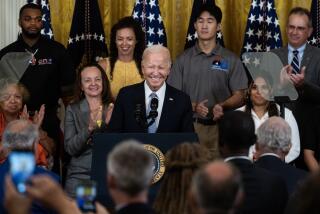Tobacco Foes Scour Pact for Smoke and Mirrors
WASHINGTON — Many veteran tobacco foes who are skeptical about Friday’s $368.5-billion settlement of tobacco litigation have long, painful memories of declaring victory in past battles--only to discover that the cigarette makers, while appearing to knuckle under, had actually strengthened their hand.
And while health authorities are divided on whether the landmark agreement between the industry and 40 state attorneys general is tough enough, some critics fear the industry may again have outmaneuvered its foes on a critical point: regulation of nicotine by the Food and Drug Administration.
The FDA’s authority to reduce nicotine levels, which the industry has challenged in court, had been a major sticking point in the intense, three-month-long negotiations that led to Friday’s announcement of an accord.
In the deal, which must be approved by Congress and the president, tobacco companies acknowledge the FDA’s power to regulate--and even eventually eliminate--the habit-forming substance that makes people keep smoking long enough to get sick.
But the full text of the agreement, obtained Saturday, shows that it places such a heavy legal burden on the agency to justify controls on nicotine, that some longtime anti-smoking advocates such as former Surgeon General C. Everett Koop and former FDA Commissioner David A. Kessler say they fear that the industry could veto any such move through a court challenge.
That part of the agreement was “seriously flawed,” Koop said Saturday. “It makes you wonder whether something was allowed to be slipped in by mistake.”
A number of lawmakers and experts are predicting that Congress may toughen the deal rather than adopting it as is, and the FDA provisions will certainly be among those drawing close scrutiny.
But if the agreement, as written, would wind up tying the FDA’s hands, it would follow a long tradition of the cigarette makers outflanking their foes.
The industry’s 1966 acquiescence on warning labels for cigarette packs was a prime example of using a “defeat” to placate its foes while preserving business as usual. Although some tobacco executives considered the weak statement--”Smoking may be hazardous to your health’--an unacceptable slur, other industry heads prevailed. They reasoned that few smokers would be influenced and that the warnings might provide some legal protection.
Indeed, the warnings became the defense--the smoker made an informed personal choice--that tobacco lawyers carried into court to ward off 30 years of lawsuits filed by smokers and their families.
Later on, tobacco foes were jubilant when Congress passed legislation banning tobacco ads on radio and television after 1970. But that too proved a Trojan horse.
In 1967, the Federal Communications Commission had ruled that the Fairness Doctrine applied to cigarette advertising, and that free air time must be provided for counter-advertising by health groups.
One such ad featured William Talman, a heavy smoker who had played Perry Mason’s legal adversary on television and who later died of lung cancer at the age of 53. Appearing gravely ill, Talman declared that he did not mind the courtroom defeats, but that he was “in a battle right now I don’t want to lose. . . . Take some advice about smoking and losing from someone who’s been doing both for years. . . . Don’t be a loser,” he said.
Such ads appeared to be highly effective, as per-capita cigarette sales dropped for four straight years from 1967 to 1970.
Then, in a seemingly gracious and diplomatic gesture, the cigarette makers caved in and backed legislation that barred them from the airwaves.
And when the cigarette ads disappeared, so too did most of the anti-smoking ads. Per capita sales immediately reversed their decline and headed back up.
The anti-smoking forces thought they had scored another win in 1984, when Congress passed legislation requiring the cigarette makers to disclose the chemicals and other additives used to flavor, moisten and control the burn rate of cigarettes.
The industry had for years successfully resisted calls for disclosure, but in the ’84 legislation, the cigarette makers embraced a compromise that was hailed by anti-smoking activists--but proved meaningless.
All the companies had to do was provide federal health officials with an annual list of additives without specifying which substances were added to which brands or in what amounts--and for good measure, public access to the lists was banned.
The memory of such episodes has triggered a certain amount of reflexive opposition to Friday’s settlement--one premise being that any deal accepted by the cigarette makers cannot be good for public health.
Even proposed advertising restrictions, which some advocates view as one of the deal’s crowning achievements, are not guaranteed to produce the desired results. The industry may be able to get around provisions restricting or banning some types of cigarette ads, said Michael Pertschuk, a former chairman of the Federal Trade Commission and longtime industry foe.
“The companies are a lot smarter at selling cigarettes than the public health people are at unselling them,” Pertschuk said.
In the case of the FDA provisions, Kessler said Saturday that they are “written in such a way that makes it virtually impossible for the FDA to regulate nicotine, with all the hurdles and burdens placed on the agency.”
Kessler and Koop said they were particularly troubled about language stating that in order to reduce nicotine in cigarettes over the next 12 years, the FDA must show by “substantial evidence” that such a move would:
* Result in a significant reduction of the health risks associated with cigarette consumers.
* Be technologically feasible.
* Not result in the creation of a black market for cigarettes that don’t meet the safety standard.
Koop said that normally, in order to justify a rule, the FDA simply has to demonstrate that it has not acted “arbitrarily or capriciously.” He stressed that having to prove something by “substantial evidence” is a considerably stiffer burden for the agency to meet.
As to the black market, Koop asked rhetorically: “How could the FDA prove a negative?”
Matthew Myers, executive director of the National Center for Tobacco Free Kids and the key public health advocate in the negotiations, acknowledged that the settlement is imperfect. The FDA provisions “are the right place in the agreement to ask questions,” he said in an interview Saturday.
*
Myers said he thinks tobacco and nicotine are different than other products regulated by the FDA because the nation has 47 million addicted smokers. “You can’t reduce nicotine levels without taking into consideration the reaction of those who are addicted to tobacco products or otherwise we’ll have both social upheaval and a guarantee that Congress will step in and make it impossible for the FDA to take any action,” Myers said.
He stressed that another part of the agreement mandates that the FDA create a scientific advisory board to study what is the best action to take with regard to nicotine.
“If that board does its job, it will provide the factual basis for the FDA to meet all three standards, including the [black market] requirement,” he said.
Despite the nicotine controversy, some observers believe that there is a world of difference between this settlement and previous tobacco compromises--a difference reflected not only in the scale of the concessions the industry has made, but in the current political climate.
Pertschuk noted that in the responses of politicians and pundits to Friday’s deal, virtually no one “spoke for the tobacco industry to say this is too harsh. . . . Every single reaction to the [deal] was either to welcome it or to raise questions about whether it was tough enough on the industry and strong enough.”
Indeed, Connecticut Atty. Gen. Richard Blumenthal said: “We’ve left more undone than we accomplished. . . . We’ve shackled and caged a beast, but we haven’t conquered it.”
The agreement between tobacco representatives, state attorneys general and private anti-tobacco lawyers is only stage one of a two-stage process.
Because the agreement would bar future state and class-action lawsuits against the industry, it must have congressional approval.
*
Under other terms, tobacco companies would pay $368.5 billion over 25 years, most of it going to the states to reimburse tobacco-related health care costs, and to fund anti-smoking campaigns and other health programs. The industry would also agree to halt all outdoor advertising and to use much larger and more ominous warning labels.
In return for these and other concessions, 40 pending state lawsuits seeking recovery of billions of dollars of health care costs and 20 large class-action suits would be dismissed. Both types of suits against the industry would be banned in the future, although individual suits could be filed. The most the industry would have to pay out in legal damages in any year, aside from reimbursement to the states, is $4 billion.
More to Read
Sign up for Essential California
The most important California stories and recommendations in your inbox every morning.
You may occasionally receive promotional content from the Los Angeles Times.










